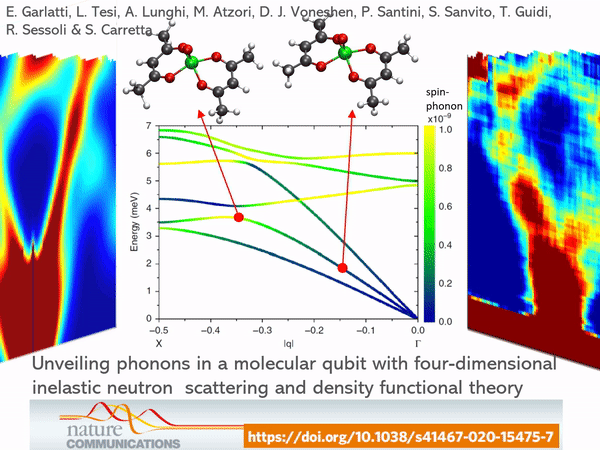Molecular nanomagnets (MNMs) have the potential for use in quantum information processing as 'qubits', or for high-density magnetic memories as classical 'bits'. However, their exploitations for either of these applications is undermined by molecular vibrations and spin-phonon interactions. For instance, molecular vibrations may play a crucial role in determining the coherence times in molecular qubits, which need to be very long to implement quantum algorithms. There are has been little research in the past on phonons in MNMs, and this study, published in Nature Communications, is the first to directly measure phonon dispersions in a molecular material with qubit applications.
The material studied in this work is a molecular crystal of VO-acetylacetonate ([VO(acac)2]), the structure of which is shown below. This molecule is a typical example of a new generation of molecular qubits with long coherence times up to high temperatures.
The international research team involved the Molecular Magnetism group of the University of Parma, Professor Elena Garlatti, Paolo Santini and Stefano Carretta, the LAMM laboratory of the University of Florence led by Professor Roberta Sessoli, who joined ISIS scientists, Dr Tatiana Guidi and Dr David Voneshen on LET for this challenging experiment.
They used four-dimensional (4D) inelastic neutron scattering (INS) to study the material, a method never applied before to study phonons in molecular crystals, such as VO(acac)2. INS is a very powerful technique to study phonons, and the recent advent of spectrometers combining the time-of-flight technique with position-sensitive detectors makes measuring the 4D scattering function in large portions of the reciprocal space possible.
Structure of the molecular qubit VO(acac)2 at equilibrium (blue) compared to the structure distorted by a low-energy phonon (green): molecular and lattice vibrations can cause decoherence of the quantum state of the qubit.
The magnetic V2+ ion is the central one in the structure. In the background: theoretical simulations of phonon dispersions measured with LET along two different directions in the reciprocal space.
Credit: E. Garlatti, et al., Nature Commun. 11, 1751 (2020).
This experiment was done on LET at ISIS because the instrument offers high-energy resolutions combined with position-sensitive detectors and multiplexing. Its high neutron flux and low background also enabled them to collect high-quality data from weakly scattering samples.
After completing their challenging 4D-INS work, the researchers compared their results to state-of-the-art density functional theory (DFT) calculations, provided by Professor Stefano Sanvito and Dr Alessandro Lunghi from Trinity College Dublin. The simulations reproduced important features of their observed data, also providing insights into the spin-phonon couplings in the system. This comparison for molecular crystals is almost unique and it could represent a new standard in the benchmarking of DFT methods.
Their results illustrate the importance of a complete description of the phonons to the understanding of relaxation dynamics in MNMs. Being able to correlate the molecular structure of these systems with their experimentally tested vibrational and phonon spectra could lead to the development of new strategies for the design of new, and optimised, molecular qubits and bits.

Further Information
This work is part of the research line of the European project QuantERA 2017 SUMO - Scaling Up quantum computation with MOlecular spins" and of the PRIN Project 2015 “QCNaMos - Quantum Coherence in Nanostructures of Molecular Spin Qubits" of the Italian MIUR. It was also supported by the “Fondazione Angelo della Riccia" and the Science Foundation Ireland.
E. Garlatti, L. Tesi, A. Lunghi, M. Atzori, D. J. Voneshen, P. Santini, S. Sanvito, T. Guidi, R. Sessoli & S. Carretta, Unveiling phonons in a molecular qubit with four-dimensional inelastic neutron scattering and density functional theory, Nature Commun. 11, 1751 (2020). https://www.nature.com/articles/s41467-020-15475-7
